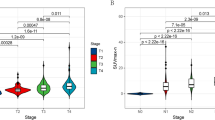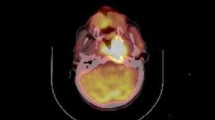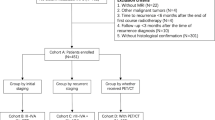Abstract
Purpose
The aim of this study was to evaluate the value of 18F-fluorodeoxyglucose (FDG) positron emission tomography (PET) in predicting tumor response to radiochemotherapy in nasopharyngeal carcinoma (NPC).
Materials and methods
From July 2012 to March 2014, 46 NPC patients who had undergone PET scanning before receiving definitive intensity-modulated radiotherapy (IMRT) treatment in our hospital were enrolled. Factors potentially affecting tumor response to treatment were studied by multiple logistic regression analysis.
Results
After radiochemotherapy, 32 patients had a clinical complete response (CR), making the CR rate 69.6 %. Multiple logistic regression analysis demonstrated that the maximal standard uptake value (SUVmax) of the primary tumor was the only factor related to tumor response (p = 0.001), and that the logistic model had a high positive predictive value (90.6 %). The area under the receiver operating characteristic (ROC) curve was 0.809, with a best cutoff threshold at 10.05. Patients with SUVmax ≤ 10 had a higher CR rate than those with SUVmax > 10 (p < 0.001).
Conclusion
The SUVmax of the primary tumor before treatment is an independent predictor of tumor response in NPC.
Zusammenfassung
Ziel
Das Ziel der Arbeit bestand darin, den Wert der 18F-Fluordesoxyglukose-Positronenemissionstomographie (18F-FDG-PET) zur Vorhersage des Tumoransprechens auf eine Radiochemotherapie beim Nasopharynxkarzinom (NPC) zu beurteilen.
Patienten und Methoden
Von Juli 2012 bis März 2014 wurden 46 NPC-Patienten, die sich vor definitiver intensitätsmodulierter Strahlentherapie (IMRT) in unserem Krankenhaus einem PET-Scan unterzogen hatten, in die Studie aufgenommen. Faktoren, die möglicherweise das Tumoransprechen auf die Behandlung beeinflussen, wurden mittels multipler logistischer Regressionsanalyse untersucht.
Ergebnisse
Nach der Radiochemotherapie hatten 32 Patienten eine klinisch komplette Remission (CR), so dass eine CR-Rate von 69,6 % erreicht wurde. Die multiple logistische Regressionsanalyse zeigte, dass der SUVmax („standard uptake value“) des Primärtumors der einzige mit dem Tumoransprechen verbundene Faktor war (p = 0,001). Das logistische Modell hatte einen hohen positiven Vorhersagewert (90,6 %). Die Fläche unter der Grenzwertoptimierungskurve (ROC-Kurve) betrug 0,809, mit dem besten Schwellenwert bei 10,05. Patienten mit einem SUVmax unter 10 hatten eine höhere komplette Remissionsrate als Patienten mit einem SUVmax über 10 (p < 0,001).
Schlussfolgerung
Der SUVmax des Primärtumors vor der Behandlung ist ein unabhängiger Prädiktor für das Tumoransprechen bei NPC.



Similar content being viewed by others
References
Vokes EE, Liebowitz DN, Weichselbaum RR (1997) Nasopharyngeal carcinoma. Lancet 350:1087–1091
Adham M, Kurniawan AN, Muhtadi AI et al (2012) Nasopharyngeal carcinoma in Indonesia: epidemiology, incidence, signs, and symptoms at presentation. Chin J Cancer 31:185–196
Lee N, Harris J, Garden AS et al (2009) Intensity-modulated radiation therapy with or without chemotherapy for nasopharyngeal carcinoma: radiation therapy oncology group phase II trial 0225. J Clin Oncol 27:3684–3690
Baujat B, Audry H, Bourhis J et al (2006) Chemotherapy in locally advanced nasopharyngeal carcinoma: an individual patient data meta-analysis of eight randomized trials and 1753 patients. Int J Radiat Oncol Biol Phys 64:47–56
Zheng J, Wang G, Yang GY et al (2010) Induction chemotherapy with nedaplatin with 5-FU followed by intensity-modulated radiotherapy concurrent with chemotherapy for locoregionally advanced nasopharyngeal carcinoma. Jpn J Clin Oncol 40:425–431
Dechaphunkul T, Pruegsanusak K, Sangthawan D et al (2011) Concurrent chemoradiotherapy with carboplatin followed by carboplatin and 5-fluorouracil in locally advanced nasopharyngeal carcinoma. Head Neck Oncol 3:30
Xie P, Yue JB, Fu Z et al (2010) Prognostic value of 18F-FDG PET/CT before and after radiotherapy for locally advanced nasopharyngeal carcinoma. Ann Oncol 21:1078–1082
Zhang N, Liang SB, Deng YM et al (2014) Primary tumor regression speed after radiotherapy and its prognostic significance in nasopharyngeal carcinoma: a retrospective study. BMC Cancer 14:136
Rades D, Kuhnel G, Wildfang I et al (2001) The value of positron emission tomography (PET) in the treatment of patients with cancer of unknown primary (CUP). Strahlenther Onkol 177:525–529
Abramyuk A, Appold S, Zophel K et al (2013) Modification of staging and treatment of head and neck cancer by FDG-PET/CT prior to radiotherapy. Strahlenther Onkol 189:197–201
Tsai MH, Shiau YC, Kao CH et al (2002) Detection of recurrent nasopharyngeal carcinomas with positron emission tomography using 18-fluoro-2-deoxyglucose in patients with indeterminate magnetic resonance imaging findings after radiotherapy. J Cancer Res Clin Oncol 128:279–282
Essler M, Wantke J, Mayer B et al (2013) Positron-emission tomography CT to identify local recurrence in stage I lung cancer patients 1 year after stereotactic body radiation therapy. Strahlenther Onkol 189:495–501
Kostakoglu L, Goldsmith SJ (2003) 18F-FDG PET evaluation of the response to therapy for lymphoma and for breast, lung, and colorectal carcinoma. J Nucl Med 44:224–239
Grigsby PW, Siegel BA, Dehdashti F et al (2004) Posttherapy [18F] fluorodeoxyglucose positron emission tomography in carcinoma of the cervix: response and outcome. J Clin Oncol 22:2167–2171
Chen H, Li Y, Wu H et al (2015) 3’-Deoxy-3’-[F]-fluorothymidine PET/CT in early determination of prognosis in patients with esophageal squamous cell cancer: comparison with [F]-FDG PET/CT. Strahlenther Onkol 191:141–152
Eisenhauer EA, Therasse P, Bogaerts J et al (2009) New response evaluation criteria in solid tumours: revised RECIST guideline (version 1.1). Eur J Cancer 45:228–247
Edge SB, Byrd DR, Compton CC et al (2010) American Joint Committee on Cancer staging manual, 7th edn. Springer, NY
Lai SZ, Li WF, Chen L et al (2011) How does intensity-modulated radiotherapy versus conventional two-dimensional radiotherapy influence the treatment results in nasopharyngeal carcinoma patients? Int J Radiat Oncol Biol Phys 80:661–668
Lin S, Pan J, Han L et al (2009) Nasopharyngeal carcinoma treated with reduced-volume intensity-modulated radiation therapy: report on the 3-year outcome of a prospective series. Int J Radiat Oncol Biol Phys 75:1071–1078
Zeng L, Tian YM, Sun XM et al (2014) Intensity-modulated radiotherapy for stage IVA/IVB nasopharyngeal carcinoma: clinical outcomes and patterns of failure in an endemic area in China. Strahlenther Onkol 190:993–1000
Phelps ME, Hoffman EJ, Mullani NA et al (1975) Application of annihilation coincidence detection to transaxial reconstruction tomography. J Nucl Med 16:210–224
Spiro SG, Buscombe J, Cook G et al (2008) Ensuring the right PET scan for the right patient. Lung Cancer 59:48–56
Wong RJ, Lin DT, Schoder H et al (2002) Diagnostic and prognostic value of [(18)F]fluorodeoxyglucose positron emission tomography for recurrent head and neck squamous cell carcinoma. J Clin Oncol 20:4199–4208
van Tinteren H, Hoekstra OS, Smit EF et al (2002) Effectiveness of positron emission tomography in the preoperative assessment of patients with suspected non-small-cell lung cancer: the PLUS multicentre randomised trial. Lancet 359:1388–1393
Lee SW, Cho KJ, Park JH et al (2005) Expressions of Ku70 and DNA-PKcs as prognostic indicators of local control in nasopharyngeal carcinoma. Int J Radiat Oncol Biol Phys 62:1451–1457
Krishna SM, James S, Balaram P (2006) Expression of VEGF as prognosticator in primary nasopharyngeal cancer and its relation to EBV status. Virus Res 115:85–90
Nakao K, Mochiki M, Nibu K et al (2006) Analysis of prognostic factors of nasopharyngeal carcinoma: impact of in situ hybridization for Epstein-Barr virus encoded small RNA 1. Otolaryngol Head Neck Surg 134:639–645
Allal AS, Slosman DO, Kebdani T et al (2004) Prediction of outcome in head-and-neck cancer patients using the standardized uptake value of 2-[18F]fluoro-2-deoxy-D-glucose. Int J Radiat Oncol Biol Phys 59:1295–1300
Atsumi K, Nakamura K, Abe K et al (2013) Prediction of outcome with FDG-PET in definitive chemoradiotherapy for esophageal cancer. J Radiat Res 54:890–898
Pelosi E, Bille A, Skanjeti A et al (2011) Prognostic role of the PET parameter maximum standardized uptake value in non small cell lung cancer: analysis in tumour of diameter >/= and <25 mm. Q J Nucl Med Mol Imaging 55:72–80
Vliegen RF, Beets-Tan RG, Vanhauten B et al (2008) Can an FDG-PET/CT predict tumor clearance of the mesorectal fascia after preoperative chemoradiation of locally advanced rectal cancer? Strahlenther Onkol 184:457–464
Folpe AL, Lyles RH, Sprouse JT et al (2000) (F-18) fluorodeoxyglucose positron emission tomography as a predictor of pathologic grade and other prognostic variables in bone and soft tissue sarcoma. Clin Cancer Res 6:1279–1287
Schulte M, Brecht-Krauss D, Heymer B et al (2000) Grading of tumors and tumorlike lesions of bone: evaluation by FDG PET. J Nucl Med 41:1695–1701
Kao CH, ChangLai SP, Chieng PU et al (1998) Detection of recurrent or persistent nasopharyngeal carcinomas after radiotherapy with 18-fluoro-2-deoxyglucose positron emission tomography and comparison with computed tomography. J Clin Oncol 16:3550–3555
Yen RF, Hung RL, Pan MH et al (2003) 18-fluoro-2-deoxyglucose positron emission tomography in detecting residual/recurrent nasopharyngeal carcinomas and comparison with magnetic resonance imaging. Cancer 98:283–287
Liu T, Xu W, Yan WL et al (2007) FDG-PET, CT, MRI for diagnosis of local residual or recurrent nasopharyngeal carcinoma, which one is the best? A systematic review. Radiother Oncol 85:327–335
Lee SW, Nam SY, Im KC et al (2008) Prediction of prognosis using standardized uptake value of 2-[(18)F] fluoro-2-deoxy-d-glucose positron emission tomography for nasopharyngeal carcinomas. Radiother Oncol 87:211–216
Li J, Pan YD, Yin JL et al (2008) Analysis of standard uptake values of 18F-FDG PET/CT in relation to pathological classification and clinical staging of nasopharyngeal carcinoma. Nan Fang Yi Ke Da Xue Xue Bao 28:1923–1924
Koga F, Fujii Y, Masuda H et al (2012) Pathology-based risk stratification of muscle-invasive bladder cancer patients undergoing cystectomy for persistent disease after induction chemoradiotherapy in bladder-sparing approaches. BJU Int 110:E203–208
Inagaki J, Fukano R, Noguchi M et al (2014) Hematopoietic stem cell transplantation following unsuccessful salvage treatment for relapsed acute lymphoblastic leukemia in children. Pediatr Blood Cancer 62:674–679
Author information
Authors and Affiliations
Corresponding author
Ethics declarations
Conflict of interest
M. Su, L. Zhao, H. Wei, R. Lin, X. Zhang, and C. Zou state that there are no conflicts of interest.
All studies on humans described in the present manuscript were carried out with the approval of the responsible ethics committee and in accordance with national law and the Helsinki Declaration of 1975 (in its current, revised form). Informed consent was obtained from all patients included in studies.
Rights and permissions
About this article
Cite this article
Su, M., Zhao, L., Wei, H. et al. 18F-fluorodeoxyglucose positron emission tomography for predicting tumor response to radiochemotherapy in nasopharyngeal carcinoma. Strahlenther Onkol 191, 642–648 (2015). https://doi.org/10.1007/s00066-015-0842-2
Received:
Accepted:
Published:
Issue Date:
DOI: https://doi.org/10.1007/s00066-015-0842-2




